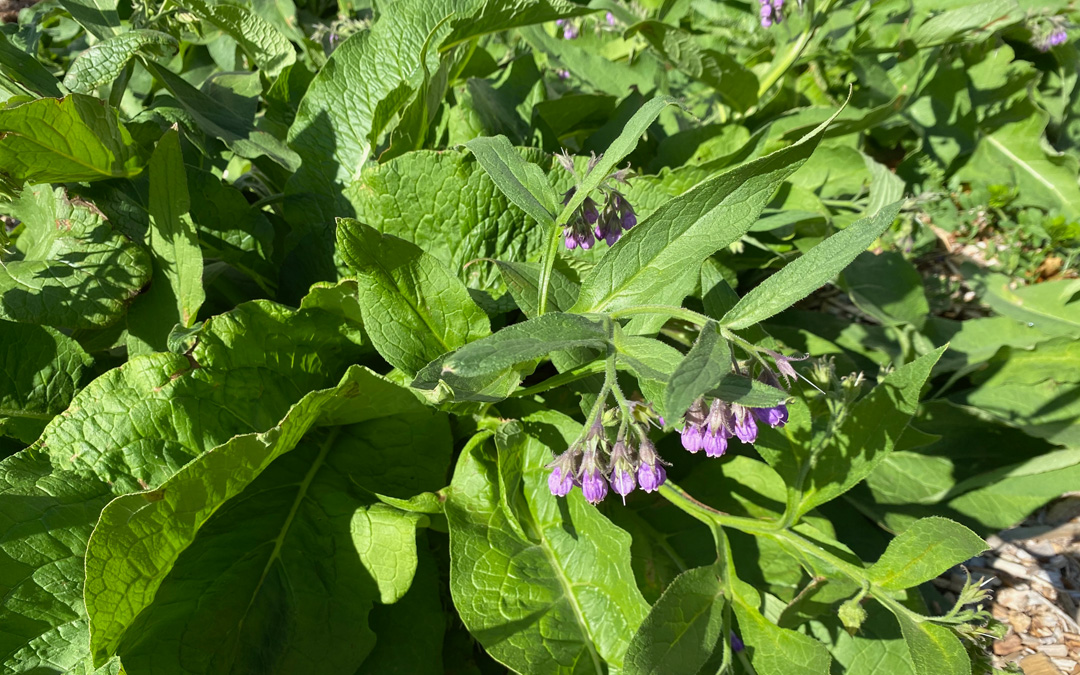Comfrey

Comfrey
In the 1970s, comfrey (Symphytum Officinale) was the ‘in’ herb. Countless articles, papers and books were written on the subject, trials held and societies formed to promote it. Sadly, it is rather obscure these days partly because in spite of evidence that it was unsafe to eat and cancer-causing if ingested, many people ignored this, some to their detriment. Comfrey has many uses including being a medium for bringing up nutrients from deep in the soil, as an activator for compost, as a first aid treatment and as a companion plant to fruit trees.
Comfrey is a perennial herb with large, thick green, hairy, pointed leaves growing in a rosette form with bell-shaped clusters of flowers that are generally blue and pink but there is a rarer white flowered variety as well. Comfrey has extremely long, black-skinned roots which can be as much as 3 metres in length. Any piece of root even as small as a centimetre long will grow. Within 6 months that piece of root is likely to be of substantial width and perhaps 24 cm in depth. Once established it is almost impossible to get rid of so be careful where you plant it.
Comfrey ‘harvests’ nutrients from deep within the soil. Its long roots absorb nutrients that have washed down into the subsoil and these are then deposited in its leaves which when broken down in the decomposition process, release into the compost. Comfrey leaves are therefore a wonderful, rich source of nutrients for the garden.
Comfrey is an activator for the compost heap. (An activator is something that causes a reaction). All activators contain large amounts of nitrogen which speed up the decomposition of plant material because it is readily digested by the microbial life already in the heap. Others include nettle, tansy, yarrow and grass clippings. Commercial activators are really of no use or certainly of no value when soft-leaf plant material containing lots of nitrogen will do the job for free.
As a first aid treatment, it is recommended that comfrey be used on closed wounds, sprains, inflammation and on the skin in the vicinity of broken bones. One of comfrey’s alternate names is knitbone. It is reputed to knit broken bones faster than normal when applied as a poultice to the area of breakage but I cannot vouch for that. Without a doubt however it will reduce inflammation and swelling when applied as a poultice to inflammatory injuries. Mature leaves are uncomfortably bristly so younger leaves are best used. I once knelt on a tack and my knee swelled hugely. I applied a poultice of leaves wrapped around the joint and held it in place with a gauze bandage before bed. The next morning there was no swelling at all and the leaves of the comfrey were transparent containing only the veins of the leaf.
Comfrey can be bought as an ointment from health food shops. Personally, I don’t use the ointment as it does not have a lot of comfrey in it but some people may find this a useful and convenient addition to the first aid kit.
Comfrey should never be eaten. It causes liver damage and is carcinogenic. For this reason, it is not recommended for use on open wounds even though it will staunch blood flow quickly.
In the garden, one of the best places to grow comfrey is next to fruit trees. Just as the leaves release nutrients into compost, leaves that die off will add nutrients to the soil next to these trees. Clumps can be slashed to produce excellent orchard mulch. Another use is to stop running weeds from spreading. It acts as a barrier if planted in rows in front of the running weed but this may well replace one problem with another! Lastly, the strong roots of comfrey break up compacted soil. I have known farmers plant acres of comfrey on poor, compacted soil – in fact, I have helped them do it – and then feed it to cattle who benefit from the protein in the leaf as well as digestible nutrients.
Trials in the 1970s were aimed at finding the ‘best’ variety of comfrey. A major trial was held at Boking in Essex, England at the Boking Research Station founded by Lawrence Hills in 1954. 21 cultivars of Russian comfrey were trialled.(Boking 1 to Boking 21). The much sought after Boking 14 variety was found to be the one most suitable for home gardens. It is sterile and does not spread by seed and is relatively contained. It has a very high leaf yield, high potash levels, is rust free and contains allantoin which gives comfrey its medicinal qualities.
Boking 14 comfrey is available from Diggers.
Written by Robin Gale-Baker
